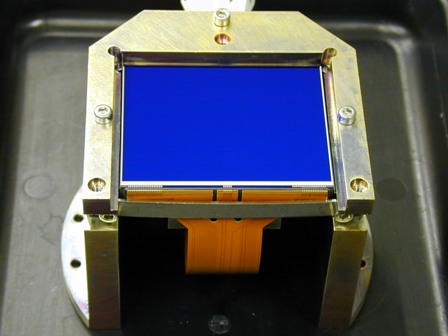e2v image sensors launched into Space to assist galaxy mapping mission

Photo by e2v technologies
On 19th December 2013,106 e2v image sensors were launched into space from Europe’s spaceport in Kourou, French Guiana as part of the European Space Agency (ESA) space observatory Gaia, a five year mission to map the galaxy.
At the heart of this remarkable space observatory is the largest focal plane array, ever to be flown in space. This focal plane array has been designed and built by Astrium and will contain a mosaic of 106 large area, high performance Charged Coupled Device (CCD) CCD91-72 image sensors, which are custom designed, manufactured and tested by e2v.
Gaia’s goal is to map the positions, parallaxes and proper motions (movement across the sky) of around 1 billion objects in our galaxy, the Milky Way, to an unprecedented accuracy. It will uncover tens of thousands of previously unseen objects, including asteroids in our Solar System, planets around nearby stars, and exploding stars – supernovas – in other galaxies. For the brightest objects, radial velocities (movement towards and away from the satellite) will be measured and photometric data taken to determine the composition of the objects. The result of this will be the most detailed map of the Milky Way ever produced allowing astronomers to determine the origin and the evolution of our Galaxy.
e2v’s specialist technology has been implemented into each of the image sensors, with functionalities like charge injection, antiblooming and TDI gate structures to meet the specific needs of the mission. There are three variants of the CCD91-72, each optimised for different wavelengths in the range 250 to 1,000nm. The CCD package is 3 sided buttable, to minimise the dead space between CCDs when they are tiled together in the mosaic and all CCDs have been through e2v’s world leading, back thinning process.
Hans Faulks, General Business Unit Manager for Space and Astronomy commented: “We are immensely proud and excited to finally see our image sensors embark on this mission. All the hard work, dedication and expertise that has been put into our sensors and into the mission will finally come to fruition. Our products will now play their part in history as we help increase our understanding of our universe.”
Giuseppe Sarri, project manager of GAIA at ESA said: “Gaia continues a European tradition for pioneering astrometry, building on the expertise generated by the first space-based astrometry mission, Hipparcos. Gaia will outdo its predecessor in terms of accuracy, limit magnitude and number of objects. It will pinpoint the position of stars with accuracy in the order of 10-300 microarcseconds (10 microarcseconds is the size of ten-cent coin on the Moon, when viewed from Earth). All this is thanks to companies like e2v, who are able to push technology to the extreme.”
For more information, please visit http://www.e2v.com.
News Categories
- » NEWS HOME
- » Automation & Robotics
- » Industry 4.0
- » Material Handling
- » Sensors
- » Quality & Testing
- » Machine Vision
- » Laser & Optics
- » Metalworking
- » Motion Control & Drives
- » Hydraulics & Pneumatics
- » Process Industry
- » Renewable Energy
- » Agriculture
- » Home & Office Furniture
- » Environmental Tech

